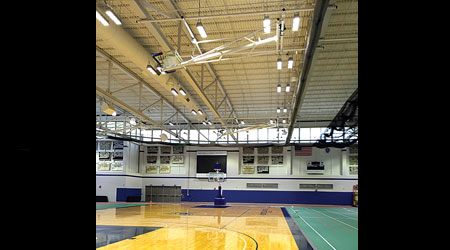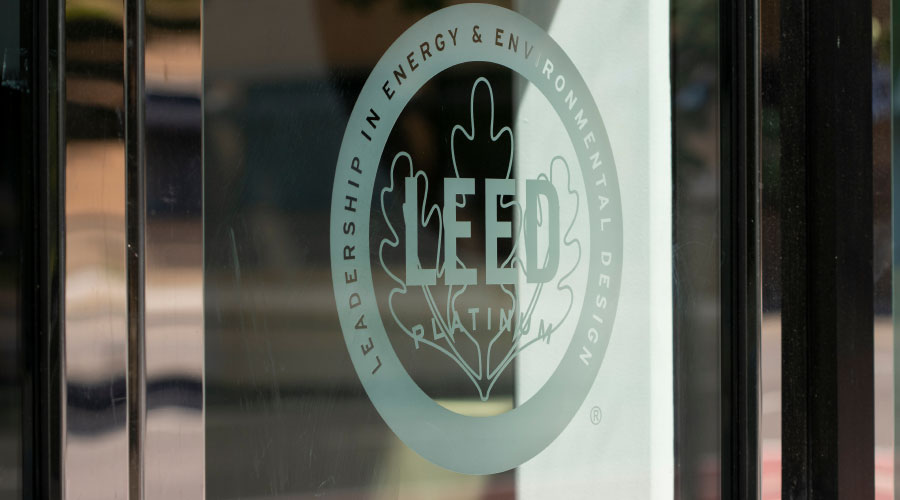Energy Lesson Plans: How Colleges Save Money on Lighting, HVAC, Water Heating
First part of a 3-part article on how educational facilities can implement energy-saving strategies.
For colleges and universities with tight operating budgets, the task of finding ways to save money often falls upon their facilities departments. The one place that most will turn to for cost savings is energy use. There are many hurdles to overcome when trying to save energy, including budget, short construction periods, and existing building conditions.
Many standards describe ways of conserving energy and improving energy efficiency. These strategies are outlined in publications by ASHRAE; the Association of Energy Engineers; APPA; and the Energy Star Building Upgrade Manual, to name a few. Some of the typical energy conservation measures implemented on college campuses involve the building envelope, lighting, boilers, chillers, air conditioning, temperature control, motors (fans and pumps), laboratory ventilation and exhaust, heat recovery, energy management systems, and even fuel switching. When performing an energy audit of a college campus it is beneficial to look at all of these as possibilities.
Based on information from the U.S. Energy Information Administration, the top three uses of energy on college campuses in the United States are lighting, HVAC, and water heating. These can vary based on the geographic location of the college and if the campus primarily uses electricity or natural gas. Lighting, ventilation, and cooling are the largest uses of electricity on many campuses, while space heating and water heating accounts for the majority of natural gas use.
Lighting Solutions
Upgrading campus lighting to energy-efficient models is one of the most popular ways to increase campus efficiency and cut down costs. Advances in LED technology have made relamping or retrofitting existing fluorescent lighting fixtures to LED lamps or fixtures very cost-effective, often resulting in paybacks of five years or less. Many utilities provide rebates for switching to LED lamps, and facility managers can take away significant benefits from these rebates. For example, a recent lighting replacement project for a Massachusetts university’s gymnasium was almost fully funded by the utility. This project involved replacing a dated lighting system in the gymnasium and providing new LED lighting and controls while also bringing the facility up to NCAA lighting standards.
Certain lighting features can lower the energy use even further and lessen the payback time frame. Lighting controls such as occupancy sensors and daylight sensors are fairly inexpensive to install, even as a retrofit, and provide great returns. Grouping fixtures into zones based on their proximity to exterior glazing and utilizing daylight sensors can provide further energy savings.
HVAC Solutions
Taken together, HVAC systems are the largest energy users on college campuses and also are among the more costly conservation measures to implement as a whole. For example, boiler plants will typically exceed a 15- to 20-year payback, especially on campuses with large boiler plants that may only have one or two aging boilers. Smaller boilers are more efficient. A campus that provides multiple smaller boilers allows for staged operation of each boiler to reach its highest efficiency. Having multiple boilers also allows for redundancy and reliability, virtually eliminating the possibility of a dorm losing heat during a mechanical failure.
If a large boiler is not ready to be replaced or the payback exceeds a set amount of time, facility managers can consider adding a smaller, more efficient boiler to handle the base load. As more heating is required, the larger boiler would be used. Another option is to decommission the boiler plant and provide multiple smaller boilers in each dorm or classroom building. This approach, when paired with a campus energy management system, allows the college to provide “on-demand” heating — only energizing boilers required to meet the heating load of each building. These smaller boilers would provide redundancy and allow for staging. Moving boilers to each building also reduces heat loss from the campus-wide distribution piping, and there is less underground piping to maintain.
While typical HVAC conservation measures are expensive, there are also low-cost HVAC energy-saving measures to consider. For example, facility managers can regulate temperatures based on outside temperatures. Due to abnormal weather conditions, like a warm winter day, radiators can still produce a significant amount of heat even though it may be 60 degrees Fahrenheit outside. A low-cost solution is this: When the building is heated with hot water, operators should program the capability for hot water reset so that the boilers are not providing 180 degree water on a 60 degree day, when providing 100 degree water would be sufficient. To further extend these energy gains, replacing the valves on the radiators with thermostatic radiator valves can significantly reduce energy use.
If a building has air handling units (AHU) for its HVAC systems, a low-cost energy conservation measure to implement is nighttime setback. Instead of providing the full amount of required outdoor air during unoccupied hours, a control sequence can be set up to provide the minimum amount of outdoor air during those periods. There may also be an opportunity to provide energy recovery units to serve areas that require large amounts of outdoor air, such as locker rooms, fitness rooms, or auditoriums. Often, depending on the age of the AHU and if the existing building use will allow, replacing the AHU with units that include total energy recovery wheels is a viable option.
Another commonly overlooked energy conservation measure is the process of reviewing the logs of the energy management system for the campus, or for each building if this information is available. Reviewing air temperatures can often lead to an opportunity to save energy if something is amiss.
For example, a college building was using an exorbitant amount of steam during the summer and shoulder months. Upon inspection of the AHU and associated piping, it was found that the valve serving the steam preheat coil was not fully closing. This was heating the incoming 95 degree air and required even more energy to cool the air back to the required leaving air temperature once it passed the cooling coil. Replacing this valve, which had been operating that way for almost two cooling seasons, saved the college a substantial amount of energy. The college has since implemented an automated system that will look for abnormalities in the energy management system logs and alert the facilities team.
Top photo caption and credit: A university replaced an aging metal halide lighting system with a new LED lighting system and controls. Installed in accordance with NCAA Division 3 tournament criteria, the lighting upgrade provided 225 footcandles for enhanced television coverage. The new controls system provides eight different lighting schemes, allowing the university to use only the amount of light required for the current use of the facility. Credit: RMF Engineering
Related Topics:













